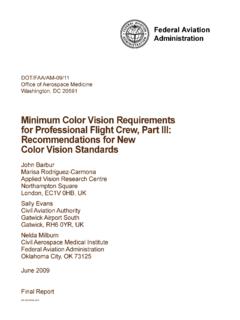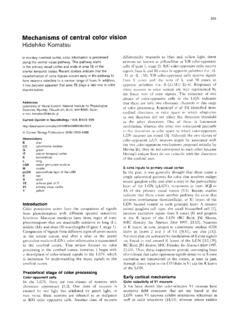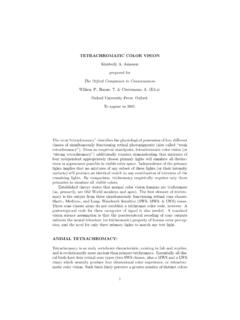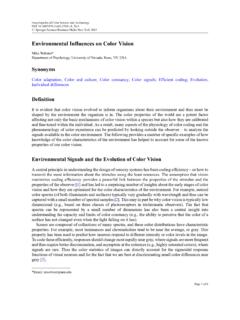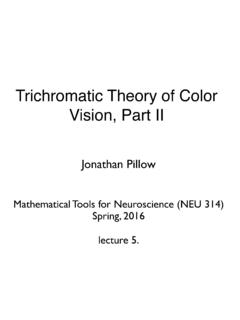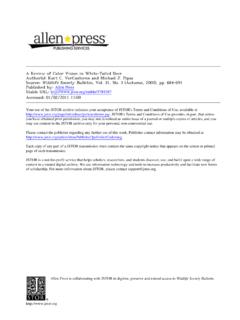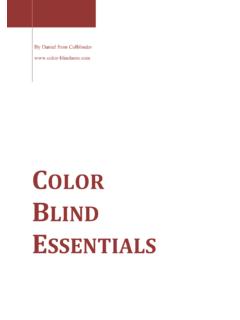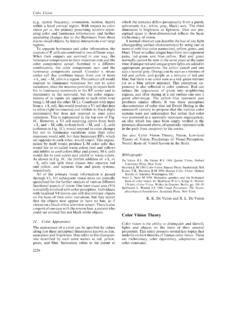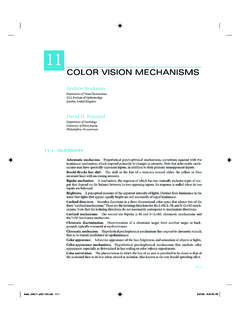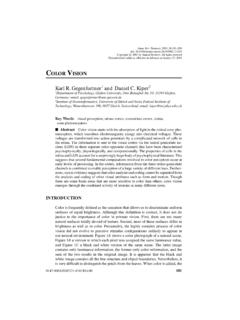Transcription of Vision Lecture 6 Notes: Color vision and adaptation
1 Color Vision and adaptation1 Central questions about Color Vision and adaptation :1. What are the basic facts and laws of Color Vision ?2. What are the major theories of Color Vision ?3. How is Color processed in the retina and the LGN?4. How is Color processed in the cortex?5. What is the nature of Color blindness? 6. How is adaptation achieved in the visual system?7. What are afterimages?2 Color vision3 Basic facts and rules of Color vision1. There are three qualities of Color : hue, brightness, saturation2. There is a clear distinction between the physical and psychologicalattributes of Color : wavelength vs. Color , luminance vs. Peak sensitivity of human photoreceptors:S = 420nm, M = 530nm, L = 560nm, Rods = 500nm4.
2 Grassman's laws:1. Every Color has a complimentary which when mixed properly yields Mixture of non-complimentary colors yields Abney's law:The luminance of a mixture of differently colored lights is equal to thesum of the luminances of the 's prism experiment(1672 at age 29)redyellowgreenblueorangeindigovioletr ed5red orangyellogreenblue indigoviolet AC circuitsBroadcastbandRadarInfrared raysUltraviolet raysX raysGamma raysWavelength in metersWavelength in NanometersThe visible spectrum10810610410210-210-410-610-810-1 010-1210-147006005004001e w Image by MIT removed due to copyright see Lecture video or the chromaticity diagram from Color circleImage by MIT Color circleImage removed due to copyright see Lecture video or Figure 3 of Derrington, Andrew M.
3 , John Krauskopf,et al. "Chromatic Mechanisms in Lateral Geniculate Nucleus of Macaque." TheJournal of Physiology 357, no. 1 (1984): theories of Color vision10 Young-Helmholtz theoryThere are three types of broadly tuned Color receptors. The colorexperienced is a product of their relative degree of : Fails to explain Grassman's 's theoryTheory of Color opponency based on the observation that red and green as well as blue and yellow are mutually exclusive. The nervous system probably treats red/green and blue/yellow as antagonisticpairs, with the third pair being black and Leonardo da Vinci: "Of different colors equally perfect, that will appear mostexcellent which is seen near its direct near yellow, green near red:because each Color is seen, when opposed to its contrary, than to any other similar to physiology of Color processing12 Image removed due to copyright blue conescontain calcium-bindingprotein calbindin-D28k13 Please see Lecture video or Figure 1 of De Monasterio, F.
4 M., E. P. McCrane, et al."Density Profile of Blue-sensitive Cones Along the Horizontal Meridian of MacaqueRetina." Investigative Ophthalmology & Visual Science 26, no. 3 (1985): removed due to copyright refer to Lecture only one out of eight cones is blue, the spatial resolution of the blue cones is lower15 The absorbtion spectra of photorecptors16 The absorbtion spectra of photorecptorsImage removed due to copyright much light of various wavelengths is absorbedby single cones and rods 17 Please see Lecture video or Figure 2 of Dartnall, H. J. A., J. K. Bowmaker,et al. "Human Visual Pigments: Microspectrophotometric Results from theEyes of Seven Persons.
5 " Proceedings of the Royal Society of London. SeriesB. Biological Sciences 220, no 1218 (1983): SYSTEMPARASOL SYSTEMONOFFONOFFN euronal response profiletimeor18 Green ON and OFF ganglion cellsRed ON and OFF ganglion cellsconesMidget and blue/yellow systemsOFFOFF bipolarsHAONOFFONOFFONOFFOFFIPL, OFFIPL, ONONOFFONON Blue/yellow ganglion cell BLUEYELLOW Yellow/blue ganglion cellYELLOW BLUEONOFF19 Color selectivity in the LGN2030 40045901351802253152705040 60 8004590135180225315270 Spikes per SecondResponse to Different Wavelength Compositions in LGNBlue ON cellYellow ON cell201006010202004590135180225315270102 0 30 4004590135180225315270maintained discharge rate10 Green OFF cellRed ON cell50304021 Major classes of midget cells in primate retinaRed ONRed OFFG reen ONGreen OFFBlue ONYellow ON22 The effects of lesions on Color vision23 Coronal section of monkey LGN24 Image removed due to copyright refer to Lecture video or Figure 4a of Schiller.
6 Peter H., and Edward "Visual Prosthesis." Perception 37, no. 10 (2008): by MIT discrimination261009080706050403020100 NORMALPLGNNORMALMLGNV4 Percent CorrectSeneca, V4, PLGN and MLGN lesionsColor DiscriminationImage by MIT saturationHigher saturationColor discrimination with varied Color saturation28 Color saturation discriminationImage removed due to copyright refer to Lecture video or Schiller, Peter H. "The Effects of V4 and MiddleT emporal (MT) Area Lesions on Visual Performance in the Rhesus Monkey."Visual Neuroscience 10, no. 4 (1993): at isoluminance30 DEPTH FORMTEXTURE MOTION DEPTH FORMTEXTURE MOTIONAt isoluminance Vision is compromised DEPTH FORMTEXTURE MOTION31 Texture, Motion and StereoImage removed due to copyright refer to Lecture video or Figure 3, 4 of Schiller, Peter H.
7 , Nikos , et al. "Parallel Pathways in the Visual System: Their Role inPerception at Isoluminance." Neuropsychologia 29, no. 6 (1991): responses at isoluminance33 MAGNO CELLS400200200200200200400400400400 of SpikesImage by MIT response of a group of magnocellular LGN cells to Color exchangeIsoluminant Color grating35 Luminance grating36 ChrominanceLuminancePercent Color contrastPercent luminance contrastSpikes per secondSpikes per second4020040200000000001600160016001600 1600160016001600 msms2244881616 Image by MIT of an MT cell to luminance and chrominance differences01450502500145001450502500145 0014500145001450014502481624816 ChrominancePercent Color contrastPercent luminance contrastLuminanceSpikes per secondSpikes per secondmsmsImage by MIT of an MT cell to luminance and
8 Chrominance differencesColor blindness and tests for it39 Color blindness1. Incidence: males: 8/100 in whites, 5/100 in asians, 3/100 in africans females: frequency 10 times less2. Types: protanopes: lack L cones deuteranopes: lack M cones tritanopes: lack S cones3. Color tests: Ishihara plates Farnsworth-Munsell Hue Test Dynamic computer test(City University Dynamic Color Vision Test)40 Ishihara plate #2. Do you see an 8 or a 3?Image is in public removed due to copyright refer to Lecture video or adapted from Figure 1 from Barbur, J. L., A. J. Harlow, et al."Insights into the Different Exploits of Colour in the Visual Cortex.
9 " Proceedings of the RoyalSociety of London. Series B: Biological Sciences 258, no. 1353 (1994): - Munsell Color testArrange in hue orderFour rows of 20 eachfarnsworth munsell Color test online45 Adaptation46 Basic facts about adaptation1. Range of illumination is 10 log units. But reflected light yields only a 20 fold change (expressed as percent contrast). 2. The amount of light the pupil admits into the eye varies over a range of 16 to 1. Therefore the pupil makes only a limited contribution to Most of light adaptation takes place in the photoreceptors. 4. Any increase in the rate at which quanta are delivered to the eye results in a proportional decrease in the number of pigment molecules available to absorb those quanta.
10 5. Retinal ganglion cells are sensitive to local contrast differences, not absolute levels of cellsto CNSH cone horizontalreceptorspigment epitheliumincoming lightphoto-conesreceptorspigment epitheliumphoto-conesrodsONOFF ganglion cellsH48 IPLOPLONOFF bipolarsONOFF ganglion cellsto CNSH cone horizontalreceptorspigment epitheliumincoming lightphoto-conespigment epitheliumEffective connections under light adapted conditionsONOFF incoming light49 IPLOPL receptorsphoto-pigment epitheliumAIION rodsamacrineONOFFto CNSONOFFE ffective connections under dark adapted conditionsincoming light504003002001000-5-4-3-2-10 Discharge rate (spikes/sec)0-1-2-3-4-5backgroundlog cd/m2 Test flash (log cd/m2)Image by MIT of a retinal ganglion cell at various background adaptation levelsThe after-effects of adaptationstabilized images afterimages52 PERCEPTION AND SYSTEM RESPONSE BEFORE AND AFTER ADAPTATIONI mage removed due to copyright refer to Lecture video or Schiller, Peter H.










